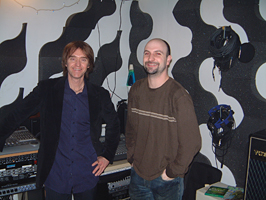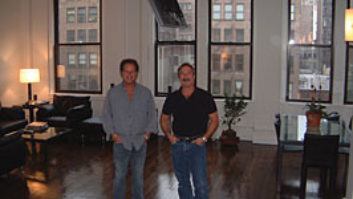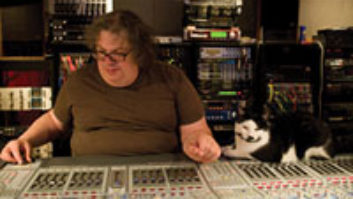
Christopher Walsh (left) and Travis McGee in the Pleasure Machine
Photo: David Weiss
In New York City, a lot of people in the business of building music need something called a “music building.” There are a few such full-on complexes — comprising spaces for rehearsing and/or recording music — in each borough, and several others that also host photographers, designers and anyone else legitimate and artistic. So much music production and development happen in these facilities.
One such music building in Brooklyn, established in an ex-warehouse in the hip industrial neighborhood of Williamsburg, is the Northside Music Complex. Founder/musician Scott Rosenthal explains why music buildings are so important in New York City, but are much less essential somewhere like Nebraska, for example: “The thing that’s unique about New York City is the population density and the economic nightmare of trying to be an artist or musician here,” he says. “You can’t get a house because it’s too expensive and you can’t practice in your apartment. However, the entertainment industry is here, there are amazing clubs, amazing bands, and so it’s incredibly desirable to be in a band in New York City. A music building like this provides a way around those constraints, and the fact that so much manufacturing has fled the city also means there’s space for a place like this.
“It’s a great way to work. If you’re in Topeka, Kansas, practicing in a basement or garage, you’re not going to run into another band when you’re going to the bathroom or having a smoke break,” Rosenthal continues. “And the advantage of today’s recording setups is that if you have a portable hard drive, you can record drums in one person’s room, capture the bass and keyboards in another room, and then mix in still another.”
The approximately 20 studios in Northside therefore serve as a viable and relatively affordable alternative for bands who have outgrown their own apartments and/or hourly rehearsal spaces, but haven’t yet moved up to the rarified territory where they can have their own private space with a quality recording setup or even a full-blown studio. Furthermore, each individual space is often shared by multiple artists coming in on different nights or perhaps collaborating, meaning that a well-run building can provide a valuable artistic haven to scores of music practitioners ranging from rank amateur to full-time pro.
One such room is The Pleasure Machine, a rehearsal/practice space behind one of the anonymous doors of Northside. The 13×8 facility is shared by two bands, McLeod Ganj and Travis McGee & The Revelers, with both bands in turn sharing bandmembers. The Pleasure Machine has been their home sweet home since December 2006, and the groups have worked together to make it a place capable of focused practicing and 100-percent functional indie-rock tracking.
“When we moved into this room, it was incredibly reverberant,” says Christopher Walsh, a guitarist, engineer and co-founder of McLeod Ganj. “There was a long shelf in the back and a concrete floor. So the first thing we did was put down carpeting.”
As the two bands began to iron out the kinks, they realized that additional sound treatment would definitely be needed. Armed with acoustical treatments and a custom layout from Auralex Acoustics, Walsh, McGee and their bandmates brought the sonics under control, helping enormously with what went on in the room, and to a certain extent with the common music building complication laying outside their room’s walls. “When a band is rehearsing in a room nearby, you notice,” Walsh says. “I do record outside clients in here, and there are times when I have to say, ‘I’m sorry, we can’t right now because there’s incredible noise and vibration.’”
The challenge of the occasional (but often regularly scheduled) noisy neighbor aside, The Pleasure Machine offers the bands multiple benefits leading to increased creativity. “Having a dedicated space isn’t just about having a place to keep your equipment,” Travis McGee adds. “[With] 24/7 access and the fact that you’re not watching the clock just enhances the whole progress of the band. Even if you only practice one day a week, just to have the time to yourself to get through stuff in the set reduces the pressure. You can relax, which is what you need to do to be in a tight and creative band.” JBL speakers, a Soundcraft mixer and AKG dynamic mics round out the rehearsal gear.
Walsh has no problem getting big sounds when tracking in this little space. He has established a logical process that works around many of the potential limitations. “The best results come when I put up a kick, snare, two overhead mics and one room mic on the kit,” he explains. “When we’re recording the drums, everything else is direct. My guitar goes through a [Line 6] PodXT, the bass player is direct and the vocalist can go over to the opposite corner and sing with a handheld. Everyone is going through a Behringer headphone system. There’s no bleed, so we get the drums down with a great deal of clarity.”
Recording into Digidesign Pro Tools Version 7.4, Walsh makes heavy use of an SSL Alpha Channel and a PreSonus DigiMax FS 8-channel mic pre to get the best possible signal for guitar, vocal and other requisite overdubs. “The rehearsal complex is now the recording complex,” Walsh says. “Most of the rooms in music buildings like Northside have a recording rig that run the gamut from a console and 2-inch machine to DAW to 4-track. People have put a lot of attention into treating their rooms so they can record. The gear is simple enough that anybody can operate it, and the size of the equipment has shrunk to such small proportions. With cheap digital gear, I can do stuff that’s respectable, and then I dedicate my budget to the mixing and mastering stages.” Walsh, McGee and co. like to keep in the Brooklyn house from there, relying primarily on Cowboy Technical Services’ Tim Hatfield to mix, and Salt Mastering’s Paul Gold to, well, you know.
Down the hall, Jay Braun works in Melody Lanes, an even more ambitious room that sports a Studer 16-track/2-inch machine, Neotek console, high ceilings and even a second floor with a pool table. “Before Northside, I was recording in what was essentially a 10-foot-wide bunker with 16-foot ceilings,” says Braun. “It was like working inside a giant cinderblock toaster. The drums sounded cool, but I knew I had to find something more workable; I knew that if I could work out of Northside, I wouldn’t have to worry about disturbing the neighbors, and the wood rafters and high ceilings didn’t hurt, either.
“The control room and live room are sort of separate from the rest of the building, which makes the whole thing feasible,” Braun continues. “Plus, I have a third ‘buffer room’ in between my space and other rooms, which is floated and serves as an editing suite, an amp room, a tight, dry drum room, and a home for all of our quirky gear like the Optigan, the Theremin and many wayward synthesizers.”
If it weren’t for music buildings, a great deal of the leading-edge music for which New York City is known would be impossible: The space and creative freedom they provide are essential for the emerging artists. “The logistics of New York City are tough to negotiate as it is, so it’s really convenient to have everything in one building,” Rosenthal says. “It was nice to start a building with 20 close friends rather than strangers. It’s really local — family style, so to speak.”
Send Metro news to [email protected].


